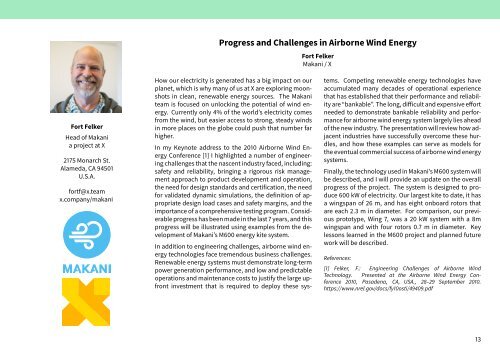Airborne Wind Energy Conference 2017 Book of Abstracts
You also want an ePaper? Increase the reach of your titles
YUMPU automatically turns print PDFs into web optimized ePapers that Google loves.
Progress and Challenges in <strong>Airborne</strong> <strong>Wind</strong> <strong>Energy</strong><br />
Fort Felker<br />
Makani / X<br />
Fort Felker<br />
Head <strong>of</strong> Makani<br />
a project at X<br />
2175 Monarch St.<br />
Alameda, CA 94501<br />
U.S.A.<br />
fortf@x.team<br />
x.company/makani<br />
How our electricity is generated has a big impact on our<br />
planet, which is why many <strong>of</strong> us at X are exploring moonshots<br />
in clean, renewable energy sources. The Makani<br />
team is focused on unlocking the potential <strong>of</strong> wind energy.<br />
Currently only 4% <strong>of</strong> the world’s electricity comes<br />
from the wind, but easier access to strong, steady winds<br />
in more places on the globe could push that number far<br />
higher.<br />
In my Keynote address to the 2010 <strong>Airborne</strong> <strong>Wind</strong> <strong>Energy</strong><br />
<strong>Conference</strong> [1] I highlighted a number <strong>of</strong> engineering<br />
challenges that the nascent industry faced, including:<br />
safety and reliability, bringing a rigorous risk management<br />
approach to product development and operation,<br />
the need for design standards and certification, the need<br />
for validated dynamic simulations, the definition <strong>of</strong> appropriate<br />
design load cases and safety margins, and the<br />
importance <strong>of</strong> a comprehensive testing program. Considerable<br />
progress has been made in the last 7 years, and this<br />
progress will be illustrated using examples from the development<br />
<strong>of</strong> Makani’s M600 energy kite system.<br />
In addition to engineering challenges, airborne wind energy<br />
technologies face tremendous business challenges.<br />
Renewable energy systems must demonstrate long-term<br />
power generation performance, and low and predictable<br />
operations and maintenance costs to justify the large upfront<br />
investment that is required to deploy these systems.<br />
Competing renewable energy technologies have<br />
accumulated many decades <strong>of</strong> operational experience<br />
that has established that their performance and reliability<br />
are “bankable”. The long, difficult and expensive effort<br />
needed to demonstrate bankable reliability and performance<br />
for airborne wind energy system largely lies ahead<br />
<strong>of</strong> the new industry. The presentation will review how adjacent<br />
industries have successfully overcome these hurdles,<br />
and how these examples can serve as models for<br />
the eventual commercial success <strong>of</strong> airborne wind energy<br />
systems.<br />
Finally, the technology used in Makani’s M600 system will<br />
be described, and I will provide an update on the overall<br />
progress <strong>of</strong> the project. The system is designed to produce<br />
600 kW <strong>of</strong> electricity. Our largest kite to date, it has<br />
a wingspan <strong>of</strong> 26 m, and has eight onboard rotors that<br />
are each 2.3 m in diameter. For comparison, our previous<br />
prototype, Wing 7, was a 20 kW system with a 8m<br />
wingspan and with four rotors 0.7 m in diameter. Key<br />
lessons learned in the M600 project and planned future<br />
work will be described.<br />
References:<br />
[1] Felker, F.: Engineering Challenges <strong>of</strong> <strong>Airborne</strong> <strong>Wind</strong><br />
Technology. Presented at the <strong>Airborne</strong> <strong>Wind</strong> <strong>Energy</strong> <strong>Conference</strong><br />
2010, Pasadena, CA, USA., 28–29 September 2010.<br />
https://www.nrel.gov/docs/fy10osti/49409.pdf<br />
13


